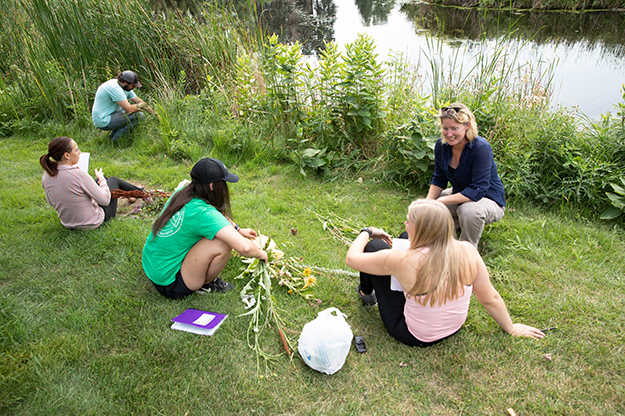‘Groundbreaking’ research on the green
UND ecologists prove diversity good for plant world, holds implications for ag, land restoration

When University of North Dakota plant ecologist Kathryn Yurkonis secured a grant from the National Science Foundation to study plant biodiversity on North Dakota’s prairie, Tom McKenna, then, a graduate student, devised his own research within the larger project.

It shaped his dissertation, a chapter of which appeared last fall in the Journal of Plant Ecology, shedding light on plant interactions and the soil that nurtures them.
“Does the soil itself get affected by the plants to the point that this negatively affects whatever is growing after it,” Yurkonis summarized McKenna’s scientific inquiry.
In short, yes. The major finding postulates that plants’ depletion of soil nutrients stymies further growth. While it may sound conspicuous, this conclusion offers important insights on soil composition and plant cultures.
For one, the paper suggests that species-specific soil biota – soil-borne organisms like nematodes (roundworms), fungi and bacteria – exerts less influence on plants than abiotic factors such as nutrient availability in the initial years of establishment.
Thus, McKenna and Yurkonis’ work buttresses the importance of legumes, or plants that fix atmospheric nitrogen to create their own fertilizer – a succor for other species. As a result, plants tend to fair better when mingled rather than when living exclusively among their kind, an arrangement known as a monoculture.
“A mix of one plant with another – like a legume – helps [plants] reap different nutritional benefits that aren’t present in monocultures,” said McKenna, who is now a post-doctoral researcher at the Kansas Biological Survey at the University of Kansas.
In and off the field
The experiments that resulted in the recently published paper, Effects of monoculture conditioned soils on common tallgrass prairie species productivity, began in the spring of 2013.

Out at UND’s Mekinock (N.D.) Field Station, McKenna planted one-meter-by-one-meter plots with monocultures of 16 tall-grass prairie species from four disparate types – warm-season grass, cool-season grass, forb and legume. Representing the latter was Canadian milkvetch, a wild member of the bean family. He then planted individuals in “home” and “away” soils to test how they affected plant growth.
After one growing season, McKenna clipped and weighed the plants’ biomass, a measure of above-ground productivity.
“That way I could tell if [a plant] grew better in soils from its own monoculture or if it grew better in soils conditioned by other plant species,” he said.
The outcome came as no surprise – soils conditioned by the Canadian milkvetch aided other species’ growth. Yet, anchored to the same soil overtime, the legume may, itself, suffer.
The second half of the trials transpired in a greenhouse, where McKenna planted the same plant species in differently treated, monoculture-conditioned soils – some heated and sterilized in order to remove biota from the soil. One grass species, switchgrass declined in the presence of soil biota, a deviation from the results in the field.
“What this told me was that there is probably an effect of generalist biota, or simply the presence of some soil biota, rather than species-specific biota,” McKenna said.
Conducted over the span of three years, McKenna’s in-field and controlled-environment tests evince that plant monocultures sap nutrients out of the soil to a cumulative magnitude that hampers their health. This limitation – more than the accumulation of species-specific soil biota – impacts subsequent growth.

Benefits to see and appreciate
McKenna and Yurkonis’ findings boast wide-ranging implications.
For a place like North Dakota, where nearly 40 million acres lie in farms, according to the 2012 census of agriculture, their work is vital.
Numerous crops mature in monocultures, a practice that may inadvertently decrease their yields while raising the cost of inputs such as herbicides and pesticides.
Understanding the interdependence between plants and the soil could transform the food industry, an effort that Yurkonis’ Grassland Ecology Lab has undertaken through collaborations with local growers.
West of the Grand Forks Air Force Base, some of them are now blending soy beans with grasses to harvest the advantages of McKenna’s work, Yurkonis said.
In Kansas, McKenna is also focused on boosting the sustainability of agricultural systems. In a partnership with the Land Institute, the microbial ecology lab he works for is looking at the effects of perennial crops on soil communities, a pursuit informed by his experiments on the prairie.
“If you switch to a perennial crop and you plant it in a monoculture,” McKenna said, “it could have an accumulation of pathogens or a depletion of nutrients. That means that you may want to plant in a mixture rather than in a monoculture.”
McKenna and Yurkonis’ paper and subsequent research could also find applications in land restoration as well as pasture development. The combination of varied vegetation enriches the soil, which, in turn, stimulates plants’ lushness.
“The science that we are doing can help plant managers and farmers alike,” said Yurkonis. “It is a benefit that we see and appreciate in this work.”


